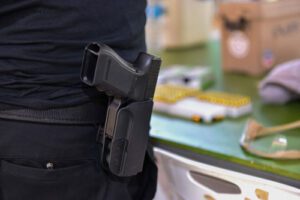 The District Court continued: The Bruen Court also emphasized the important balance that District Courts must strike when considering statutes that plainly implicate the Second Amendment: analogical reasoning under the Second Amendment is neither a regulatory straightjacket nor a regulatory blank check. On the one hand, courts should not “uphold every modern law that remotely resembles a historical analogue,” because doing so “risks endorsing outliers that our ancestors would never have accepted.” Drummond v. Robinson, 9 F.4th 217, 226 (CA3 2021).
The District Court continued: The Bruen Court also emphasized the important balance that District Courts must strike when considering statutes that plainly implicate the Second Amendment: analogical reasoning under the Second Amendment is neither a regulatory straightjacket nor a regulatory blank check. On the one hand, courts should not “uphold every modern law that remotely resembles a historical analogue,” because doing so “risks endorsing outliers that our ancestors would never have accepted.” Drummond v. Robinson, 9 F.4th 217, 226 (CA3 2021).
On the other hand, analogical reasoning requires only that the government identify a well-established and representative historical analogue, not a historical twin. So even if a modern-day regulation is not a dead ringer for historical precursors, it still may be analogous enough to pass constitutional muster. Id. at 2133. The Bruen Court further instructed “that Heller and McDonald point toward at least two metrics: how and why the regulations burden a law-abiding citizen’s right to armed self-defense.” Id. And as stated in those precedential cases, “individual self-defense is the central component of the Second Amendment right.” Id. (internal quotations and citations omitted). And central to the consideration of a reviewing District Court is “whether modern and historical regulations impose a comparable burden on the right of armed self-defense and whether that burden is comparably justified.” Id. (citations omitted).
Of critical importance to the current controversy, the Bruen Court expressly considered and commented upon the permissibility of the type of “sensitive place” legislation at issue here: Consider, for example, Heller’s discussion of “longstanding” laws forbidding the carrying of firearms in sensitive places such as schools and government buildings. Although the historical record yields relatively few 18th- and 19th-century “sensitive places” where weapons were altogether prohibited—e.g., legislative assemblies, polling places, and courthouses—we are also aware of no disputes regarding the lawfulness of such prohibitions. We therefore can assume it settled that these locations were “sensitive places” where arms carrying could be prohibited consistent with the Second Amendment. And courts can use analogies to those historical regulations of “sensitive places” to determine that modern regulations prohibiting the carry of firearms in new and analogous sensitive places are constitutionally permissible.
Judge Bumb’s analysis is thoughtful and commendable. It is unfortunate that many commentators would refer to her as “a right-wing activist” just because they favor gun control laws. An “activist” would have seized on the lack of precedent that supports treating “government buildings” as sensitive places. On the other hand, a judge who works in a government building has an additional motivation to prohibit the public from carrying guns into her workplace.
